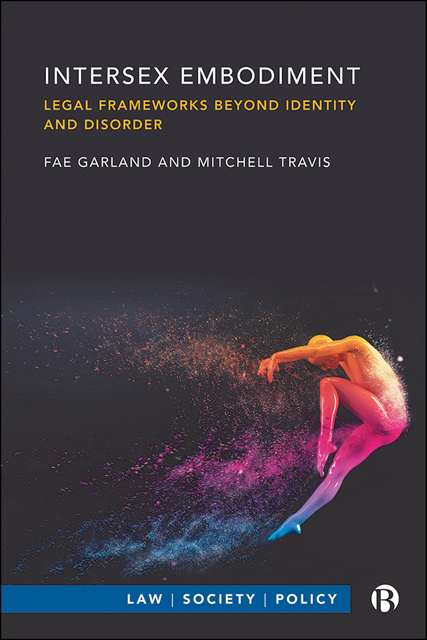Book contents
- Frontmatter
- Dedication
- Contents
- Series Editor’s Preface
- List of Abbreviations
- Acknowledgements
- 1 Introduction: Embodying Intersex
- 2 Medical Embodiment: Intersex as Disorder
- 3 Non-Binary Embodiment: Intersex and Third-Gender Markers
- 4 LGBT Embodiment: Queerness, Homonormativity and Anti-Discrimination Law
- 5 Engaging with Intersex Experience: Can Law Disrupt Medical Embodiment?
- 6 Intersex as Acceptance and Emergence: Can Psychosocial Frameworks Disrupt Medical Embodiment?
- 7 Conclusion: Intersex Embodiment
- References
- Index
3 - Non-Binary Embodiment: Intersex and Third-Gender Markers
Published online by Cambridge University Press: 17 June 2023
- Frontmatter
- Dedication
- Contents
- Series Editor’s Preface
- List of Abbreviations
- Acknowledgements
- 1 Introduction: Embodying Intersex
- 2 Medical Embodiment: Intersex as Disorder
- 3 Non-Binary Embodiment: Intersex and Third-Gender Markers
- 4 LGBT Embodiment: Queerness, Homonormativity and Anti-Discrimination Law
- 5 Engaging with Intersex Experience: Can Law Disrupt Medical Embodiment?
- 6 Intersex as Acceptance and Emergence: Can Psychosocial Frameworks Disrupt Medical Embodiment?
- 7 Conclusion: Intersex Embodiment
- References
- Index
Summary
Introduction
The last chapter traced the historical pathologization of intersex and how medicine came to dominate contemporary understandings and approaches to intersex embodiment. The result of this medical framing has not only been routine irreversible interventions performed on intersex children, but also the cultural and institutional disappearance of intersex as a concept. Medical erasure has worked to reify medical power/knowledge by making it extremely difficult for the intersex community to come together and challenge medical practice or to identify alternative conceptualizations of intersex embodiment. Accordingly, much activist work has centred on disrupting medical embodiment by raising awareness of intersex as the starting point to improve lived experiences and ultimately stop medical interventions on children. This chapter traces the most prevalent way in which intersex embodiment has become recognized in non-medical realms – outside binary conceptions of sex and gender.
To begin with, the chapter traces the different ways in which institutions have recognized intersex embodiment as outside the binary. While some contemporary approaches have depicted intersex embodiment as synonymous with non-binary identity, historical institutional approaches viewed intersex embodiment as a childhood place-holder for the two-sex model. This often facilitated a more enlightened (although not unproblematic) approach to intersex embodiment than seen in modern discourse with themes of flexibility, deferability and, to some degree, individual lived experience and autonomy appearing within and informing legal frameworks.
The chapter then juxtaposes this to some present-day understandings of intersex embodiment which have placed intersex within a legal three-sex model. This epistemological shift from place-holder to non-binary has been heavily influenced by feminist and queer writings in this area as well as the growing visibility and organization of the non-binary trans movement. Discursively, this view has been reaffirmed by a number of high-profile news stories where intersex people have claimed that the state ought to legally recognize their sex as something other than male or female (Davidson, 2014; Associated Press in Denver, 2015; Anonymous, 2016; Jarvis, 2018; Bowcott, 2019). In many jurisdictions, this non-binary conception of intersex embodiment has been cemented within law and policy for adults and children alike: Australia permits adult individuals to have third markers on identity documents such as passports, and jurisdictions like Chile and Germany have included third markers on birth certificates for children with indeterminate sex.
- Type
- Chapter
- Information
- Intersex EmbodimentLegal Frameworks beyond Identity and Disorder, pp. 51 - 77Publisher: Bristol University PressPrint publication year: 2022



